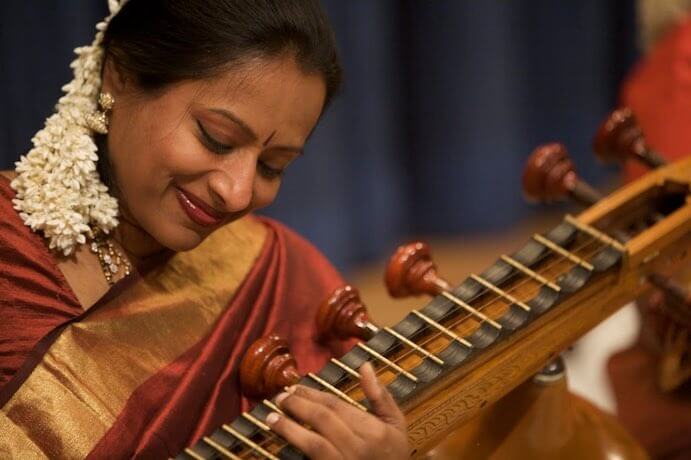“Out of Context” is a 10-part series that addresses the topic of cultural appropriation as it intersects with both Western European-based classical music and the broader social landscape. Commissioned by American Composers Forum and I CARE IF YOU LISTEN, the goal of the series is to offer information and diverse perspectives to those seeking to acknowledge historical context, honor cultural traditions that are not their own, and expand their sphere of knowledge with awareness and respect. A culminating collection of these articles and other resources will be shared for continued learning and dialogue.
Cultural appropriation is not a buzzword or hypothesis. It is a process where the creative knowledge and skills of marginalized artists are exploited by individuals and institutions with systemic privileges. Most often, this process manifests through a lack of adequate financial compensation and public acknowledgement. In U.S. history, cultural appropriation’s most popular representative is the racist, 19th century genre minstrelsy and its continued manifestation in modern popular culture. But where popular music is often the setting for these discussions, Western classical music has too often escaped the necessary call-ins.
There are many examples of appropriation in our [Western classical musicians’] history: Claude Debussy’s use of ragtime elements and racist caricature in “Golliwog’s Cakewalk” from Children’s Corner; the exotification of Roma culture in Pablo Sarasate’s Zigeunerweisen; and more recently, Roomful of Teeth’s use of Inuit throat singing. But what makes these examples different from, say, Nina Simone improvising a fugue in “Love Me or Leave Me,” Margaret Bonds composing the cantata The Ballad of the Brown King, or Kronos Quartet featuring Inuit throat singing? The difference is the relationship to power. Simone trained and deeply desired to be a concert pianist; but her aspirations were diverted by racist practices. Bonds also studied classical piano and, thanks in no small part to the communities she lived within, built a successful career as a composer. Kronos Quartet’s Tundra Songs album is a tripartite collaboration between the ensemble, Inuit experimental vocalist Tanya Tagaq, and Canadian composer Derek Charke. The album is the Quartet’s, with all music composed by Charke and Tagaq as a featured artist. This citation reflects the group’s acknowledgement and respect for Tagaq’s skills and knowledge of Inuit throat singing, a technique that should only be performed by those with extensive community connection.
Music cannot be created, cannot be sustained, without the exchange of creative practices and ideas. But sometimes these exchanges are not equitable or respectful, leading one party to receive the praise and credit at the expense of another (or others). It is this power imbalance that sits at the core of cultural appropriation. As I read through the previous essays of I CARE IF YOU LISTEN and American Composers Forum’s “Out of Context” series, three themes stuck out to me that are essential to help us chip away at cultural appropriation’s stone columns: Acknowledge–Decenter–Care.
Acknowledge
As a high schooler and college student, my citation practice was rooted in a fear of accidental plagiarism. Even if it was information I’d known for years, I made sure to cite a written source. Now, my practice is not rooted in fear, but in awareness of the politics of citation. Whose knowledge systems are prioritized and whose are not? This is why Immanuel Kant was more familiar to me than Sylvia Wynter. It’s why, as a Florence Price scholar, I need to always stay abreast of new scholarship not only in musicology, but Black music studies, Black feminist theory, sociology, and intersectionality. To not do so wouldn’t just be a glaring faux pas, but grossly irresponsible.
To flippantly engage with marginalized music practices has been standard practice in our Western culture-dominated world. In their “Out of Context” essays, Anthony Tan and Nicholas Lell Benavides discuss some solutions (but not cures) to this systemic problem. Tan discusses the difference between cultural appropriation versus appreciation. Practicing cultural appreciation requires giving marginalized musical objects and traditions proper citation and context, especially if the creator of the object is unclear, or the musical object in question comes from a tradition of communal ownership. Benavides lists specific ways privileged individuals can engage and support marginalized musicians and traditions: learn the history and context of that new technique; recognize some traditions cannot be shared without extensive community connections and trust; donate to an ensemble that performs works by marginalized composers. These acts will not break cultural appropriation overnight. But they are important steps to recognize and correct the habits that perpetuate it.

Photo by Raymond Teeuw on Unsplash
Decenter
While studying Florence B. Price’s concertos (one for piano, two for violin), I realized I needed different analytic tools. Traditional Western music analysis was only getting me so far. So I revisited and incorporated Black music studies frameworks: Samuel Floyd’s signifyin(g), Guthrie Ramsey’s Call Response, and Imani Perry’s Black formalism, which illuminated Price’s specific approaches to melodic quotation, development, and formal structure. Though Western music analysis is still part of my dissertation approach, I needed to decenter it to acquire deeper knowledge of Price’s musical decisions.
The essays of Elizabeth A. Baker, Hon Ki Cheung, inti figgis–vizueta, and Aisha Staggers address the following: classical music as a tool of cultural oppression; how non-Western music cultures can work against stereotypical portrayals of their traditions in Western educational systems and societies; the ways discriminatory ideas of Indigenous musics obscure tradition as an active, cultural-informed practice; and how the white-washing of Prince stems from the white public’s discomfort regarding the late musician’s public support and rootedness in Black music practices and political movements. Through different topics, the authors communicate the following: the experiences of white people and Western methods of knowledge production and interpretation cannot be the litmus by which all musics created in Western contexts are studied.

Photo by Lechon Kirb on Unsplash
There are whole systems of music theory, notation, and performance practice that exist outside of Western systems or incorporate aspects of Western culture without centering them. These authors show what is brutally undermined when music by Indigenous peoples and people of color are discussed from one epistemological angle. They show us what is illuminated when these communities’ music histories and systems are centered. Marginalized music artists want to share their work with many audiences; but if we are to respect their work, we need to center the many methods of musical production and comprehension that people of color and Indigenous nations have built over generations and continue to build into the present day.
Care
As a violin student, I was taught early the importance of learning my repertoires’ contextual details. But it was less straightforward when I needed details about William Grant Still’s Suite for Violin and Piano (1943) for my college recital. It took digging; persistent, sometimes frustrating digging, but I found the sources I needed. Like all the classical repertoire I had learned up to that point, I needed to have a basic contextual understanding of the work to craft my interpretive stance and share it with my audiences. I needed to approach the work with care.
The contributions of Shruthi Rajasekar, Chevall Pryce, and Brent Michael Davids magnify how the practice of care–to care, to be careful, to handle respectfully–is essential in dismantling cultural appropriation practices. Shruthi Rajasekar introduces us to her mother, Carnatic musician Nirmala Rajasekar, a musician keenly aware that her performances are also opportunities for education, especially for audiences unfamiliar with Carnatic music. This approach differs from the standard slapdash of diverse programming, where traditions and repertoires by people of color are interchangeable and are given the bare minimum of contextual engagement. To avoid this, Shruthi Rajasekar advises every music director to ask and answer for themselves: “why am I programming this repertoire?” Programming decisions should come from a place where the music, its creator(s), and its context are studied with care, an act given to Western classical repertoire without a second thought.

Nirmala Rajasekar–Photo courtesy www.nirmalarajasekar.com
As Chevall Pryce takes us through his decision to wear dreadlocks, we see several layers of care at work: reading on the hair style’s history; embracing the Black cultural pride locs help signify; finding a regime that worked for his hair; and navigating American culture’s racist hair politic, where white people with dreads are “cool” and Black people with locs are anything but. Pryce’s essay emphasizes the need for care when engaging with a cultural practice that has and continues to be the target of discrimination; to consider how one’s privileged position can exacerbate rather than redress offensive practices.
Brent Michael Davids looks at two 2001 reviews of his Powwow Symphony, which show how little the reviewers understood (or just straight up ignored) the Native American music systems at the core of Davids’ composition. Music reviewers are supposed to communicate details of style, context, and interpretation to their readers. So then why is it permissible for a writer to display their ignorance of music practices of Indigenous nations and people of color for all to see? Because it is systemically supported. Because of a lack of care. Treating Indigenous voices, perspectives, and music traditions with care by putting them front and center is part of Davids’ musical call-in, a model for classical music that is horizontal and balanced instead of vertical and exploitative. It is a model that, while contextually specific, has the potential to make classical music spaces not only welcoming but supportive of marginalized artists who recognize the Western world is not the center of their creative visions.
Cultural appropriation is an ingrained practice. It will not be dismantled without institutional changes. These authors provide us with specific actions: acknowledgement of sources, decentering of Western culture, and treating all music traditions with care, that can help make Western classical music spaces respectful and equitable. Let’s put them to use.
I CARE IF YOU LISTEN is a program of the American Composers Forum, funded with generous donor and institutional support. A gift to ACF helps support the work of ICIYL. Editorial decisions are made at the sole discretion of the editor-in-chief. For more on ACF, visit the “At ACF” section or composersforum.org.





















